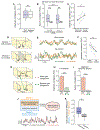Correlated Neural Activity and Encoding of Behavior across Brains of Socially Interacting Animals
- PMID: 31230711
- PMCID: PMC6625832
- DOI: 10.1016/j.cell.2019.05.022
Correlated Neural Activity and Encoding of Behavior across Brains of Socially Interacting Animals
Abstract
Social interactions involve complex decision-making tasks that are shaped by dynamic, mutual feedback between participants. An open question is whether and how emergent properties may arise across brains of socially interacting individuals to influence social decisions. By simultaneously performing microendoscopic calcium imaging in pairs of socially interacting mice, we find that animals exhibit interbrain correlations of neural activity in the prefrontal cortex that are dependent on ongoing social interaction. Activity synchrony arises from two neuronal populations that separately encode one's own behaviors and those of the social partner. Strikingly, interbrain correlations predict future social interactions as well as dominance relationships in a competitive context. Together, our study provides conclusive evidence for interbrain synchrony in rodents, uncovers how synchronization arises from activity at the single-cell level, and presents a role for interbrain neural activity coupling as a property of multi-animal systems in coordinating and sustaining social interactions between individuals.
Keywords: calcium imaging; hyperscanning; interbrain synchrony; mPFC; miniscope; mouse; neural circuit; prefrontal cortex; social behavior; social dominance.
Copyright © 2019 Elsevier Inc. All rights reserved.
Conflict of interest statement
DECLARATION OF INTERESTS
The authors declare no competing interests.
Figures








Comment in
-
Social Minds Sync Alike.Cell. 2019 Jul 11;178(2):272-274. doi: 10.1016/j.cell.2019.06.019. Cell. 2019. PMID: 31299199
References
-
- Babiloni F, Cincotti F, Mattia D, Mattiocco M, De Vico Fallani F, Tocci A, Bianchi L, Marciani MG, Astolfi L (2006). Hypermethods for EEG hyperscanning. 2006 International Conference of the IEEE Engineering in Medicine and Biology Society (pp. 3666–3669). - PubMed

